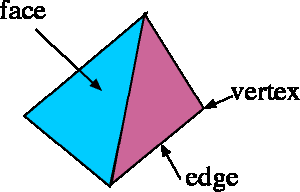Relational models excel in various tricks to deploy relations that the relational approach does not contain. Examples are the n:m relationship, the candidate key, the nested set, and on. When you think of ERD for visualising the structures, use vertex for the entity and edge for the relationship. A planar is a simplified model for a collection of coherent vertices and edges. Boxary does not map ERD to Graph; it is merely a 1:1 transformation rule with a target to visualise the structure diagram.

A vertex contains a unique key and attributes. View its anatomy.
A edge contains foreign keys and a label. View its anatomy.
When a structure is visualised with vertices and edges (and planars constituting the application model), you may detect empty space between them, which is called a face. In this way a face has boundaries of vertices and edges. It is common to view this face as a html-page segment of your application. In mvc terminology it is comparable with the view. In mvc the view changes when the model changes; in Boxary it does not because the application traverses the graph and each step delivers a new view in stead of changing the current view. In this way a face is like a bounded window on the canvas, which moves around when traversing.
With this concept in mind, the vertexFace is typical a form, the edgeFace a list(ing), the planarFace manifests the total of the application components and the canvasFace is essentially nothing more than the frameworks plus the domain rules to interact with the user.
In OO terms the canvas and associated classes contain the inheritable methods and - members.